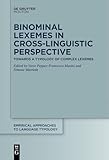Binominal Lexemes in Cross-Linguistic Perspective : Towards a Typology of Complex Lexemes / ed. by Steve Pepper, Francesca Masini, Simone Mattiola.
Material type: TextSeries: Empirical Approaches to Language Typology [EALT] ; 62Publisher: Berlin ; Boston : De Gruyter Mouton, [2022]Copyright date: ©2023Description: 1 online resource (VI, 472 p.)Content type:
TextSeries: Empirical Approaches to Language Typology [EALT] ; 62Publisher: Berlin ; Boston : De Gruyter Mouton, [2022]Copyright date: ©2023Description: 1 online resource (VI, 472 p.)Content type: - 9783110640878
- 9783110673524
- 9783110673494
- 415 23/eng/20221026
- P299.B56 .B56 2023
- online - DeGruyter
- Issued also in print.
| Item type | Current library | Call number | URL | Status | Notes | Barcode | |
|---|---|---|---|---|---|---|---|
 eBook
eBook
|
Biblioteca "Angelicum" Pont. Univ. S.Tommaso d'Aquino Nuvola online | online - DeGruyter (Browse shelf(Opens below)) | Online access | Not for loan (Accesso limitato) | Accesso per gli utenti autorizzati / Access for authorized users | (dgr)9783110673494 |
Frontmatter -- Contents -- Exploring complex lexemes cross-linguistically -- Part 1: Form (morphosyntactic strategies) -- Defining and typologizing binominal lexemes -- Binominals and construct marking -- Compounds and other nominal modifier constructions in Pama-Nyungan languages -- New types of binominal lexeme in Anindilyakwa (Australia) -- Binominals in Äiwoo: Compounds, possessive constructions, and transitional cases -- NN.gen and NArel juxtapositions in Polish: Syntactic schemas employed in building phrasal nouns -- The derivational use of classifiers in Western Amazonia -- Binominals denoting instruments: A contrastive perspective -- Part 2: Meaning (semantic relations) -- Hatcher-Bourque: Towards a reusable classification of semantic relations -- Binominal strategies and semantic correlations in Turkic languages -- A classification of compounds in Karachay-Balkar -- Binominal lexemes in Moksha and Hill Mari -- Part 3: Acquisition -- Binominals and potential competitors in language development: Evidence from Swedish -- List of contributors -- Index of Subjects -- Index of Languages
restricted access online access with authorization star
http://purl.org/coar/access_right/c_16ec
The typological, contrastive, and descriptive studies in this volume investigate the strategies employed by the world’s languages to create complex denotations by combining two noun-like elements, together with the kinds of semantic relation they involve, and their acquisition by children. The term ‘binominal lexeme’ is employed to cover both noun-noun compounds and a range of other naming strategies, including prepositional compounds, relational compounds, construct forms, genitival constructions, and more. Overall, the volume suggests a new, cross-linguistic approach to the study of complex lexeme formation that cuts across the traditional boundaries between syntax, morphology, and lexicon.
Issued also in print.
Mode of access: Internet via World Wide Web.
In English.
Description based on online resource; title from PDF title page (publisher's Web site, viewed 25. Jun 2024)


